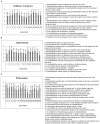Continuity of Care During COVID-19 Lockdown: A Survey on Stakeholders' Experience With Telerehabilitation
- PMID: 33519697
- PMCID: PMC7838679
- DOI: 10.3389/fneur.2020.617276
Continuity of Care During COVID-19 Lockdown: A Survey on Stakeholders' Experience With Telerehabilitation
Abstract
Objective: To explore professionals', adult patients', and children's caregivers' perception and satisfaction with telerehabilitation during COVID-19 lockdown. Design: An observational transversal study on a web-based survey was conducted in order to explore participants' perception and satisfaction of telerehabilitation during COVID-19 lockdown. Setting: The study was conducted at our Outpatient Neurorehabilitation Service. Subjects: All rehabilitation professionals, adult patients, and children's caregivers who accepted telerehabilitation were recruited. Interventions: Participants had to respond to the Client Satisfaction Questionnaire-8 and to a purpose-built questionnaire on their perception and satisfaction of the service provided. Main Measures: Data were analyzed by qualitative statistics and logistic regression models. Results: All 144 caregivers, 25 adult patients, and 50 professionals reported a medium-high level of perception and a high level of satisfaction. Results showed a correlation among caregivers of children aged 0-3 and feeling overwhelmed with remote care (OR = 3.27), a low perception of telerehabilitation for enhancing goals (OR = 6.51), and a high perception of feeling helped in organizing daily activity (OR = 2.96). For caregivers of children aged over 6 years, changes in the therapy plan were related to a low perception of feeling in line with the in-person therapy (OR = 2.61 and OR = 9.61) and a low satisfaction (OR = 5.54 and OR = 4.97). Changes in therapy were related to concern (OR = 4.20). Caregivers under 40 and professionals showed a high probability to perceive telerehabilitation as supportive (OR = 2.27 and OR = 5.68). Level of experience with remote media was shown to influence perception and satisfaction. Interpretation: Telerehabilitation can be a useful practice both during a health emergency and in addition to in-presence therapy.
Keywords: COVID-19; caregivers; continuity of care; perception; rehabilitation professionals; satisfaction; telerehabilitation.
Copyright © 2021 Assenza, Catania, Antenore, Gobbetti, Gentili, Paolucci and Morelli.
Conflict of interest statement
The authors declare that the research was conducted in the absence of any commercial or financial relationships that could be construed as a potential conflict of interest.
Figures



Similar articles
-
Rehabilitation services lockdown during the COVID-19 emergency: the mental health response of caregivers of children with neurodevelopmental disabilities.Disabil Rehabil. 2021 Jan;43(1):27-32. doi: 10.1080/09638288.2020.1842520. Epub 2020 Nov 10. Disabil Rehabil. 2021. PMID: 33167738
-
Caregivers' Perceptions and Willingness to Utilize Telerehabilitation for Outpatient Consultation and Therapy for Pediatric Patients in a COVID-Referral Center in a Developing Country: A Cross-sectional Study.Acta Med Philipp. 2024 Nov 15;58(20):20-28. doi: 10.47895/amp.v58i20.8713. eCollection 2024. Acta Med Philipp. 2024. PMID: 39664622 Free PMC article.
-
The Impact of Personality Traits on Patient Satisfaction after Telerehabilitation: A Comparative Study of Remote and Face-to-Face Musculoskeletal Rehabilitation during COVID-19 Lockdown.Int J Environ Res Public Health. 2023 Mar 12;20(6):5019. doi: 10.3390/ijerph20065019. Int J Environ Res Public Health. 2023. PMID: 36981927 Free PMC article.
-
Effectiveness and Acceptability of Telerehabilitation in Physical Therapy during COVID-19 in Children: Findings of a Systematic Review.Children (Basel). 2021 Nov 29;8(12):1101. doi: 10.3390/children8121101. Children (Basel). 2021. PMID: 34943295 Free PMC article. Review.
-
Impact of a Remotely Supervised Motor Rehabilitation Program on Maternal Well-Being During the COVID-19 Italian Lockdown.Front Psychol. 2022 Mar 7;13:834419. doi: 10.3389/fpsyg.2022.834419. eCollection 2022. Front Psychol. 2022. PMID: 35345633 Free PMC article. Review.
Cited by
-
COVID-19 Pandemic Experiences of Families in Which a Child/Youth Has Autism and Their Service Providers: Perspectives and Lessons Learned.J Autism Dev Disord. 2025 Aug;55(8):2706-2717. doi: 10.1007/s10803-024-06402-6. Epub 2024 May 20. J Autism Dev Disord. 2025. PMID: 38767817 Free PMC article.
-
Telerehabilitation: A Practical Remote Alternative for Coaching and Monitoring Physical Kinetic Therapy in Patients with Mild and Moderate Disabling Parkinson's Disease during the COVID-19 Pandemic.Parkinsons Dis. 2022 Aug 8;2022:4370712. doi: 10.1155/2022/4370712. eCollection 2022. Parkinsons Dis. 2022. PMID: 35979169 Free PMC article.
-
Role of telerehabilitation in the rehabilitation of children with cerebral palsy during COVID-19: A review.Medicine (Baltimore). 2024 Mar 1;103(9):e37214. doi: 10.1097/MD.0000000000037214. Medicine (Baltimore). 2024. PMID: 38428904 Free PMC article. Review.
-
Acceptability of Telerehabilitation for Magnification Devices for the Visually Impaired Using Various Approaches to Facilitate Accessibility.Transl Vis Sci Technol. 2022 Aug 1;11(8):4. doi: 10.1167/tvst.11.8.4. Transl Vis Sci Technol. 2022. PMID: 35917136 Free PMC article. Clinical Trial.
-
Telerehabilitation and Wellbeing Experience in Children with Special Needs during the COVID-19 Pandemic.Children (Basel). 2021 Nov 1;8(11):988. doi: 10.3390/children8110988. Children (Basel). 2021. PMID: 34828702 Free PMC article.
References
-
- Attkisson CC, Greenfield K. The ucsf client satisfaction scales: I. The client satisfaction questionnaire-8. In: Maruish M, editor. The Use of Psychological Testing for Treatment Planning and Outcome Assessment. 3rd ed. Mahwah, NJ: Lawrence Erlbaum Associates; (2004).
-
- Attkisson CC, Greenfield TK. The client satisfaction questionnaire (CSQ) scales and the service satisfaction scale-30 (SSS-30). In: Seder LL, Dickey B, editors. Outcome Assessment in Clinical Practice. Baltimore: Williams & Wilkins; (1996).
LinkOut - more resources
Full Text Sources
Other Literature Sources

